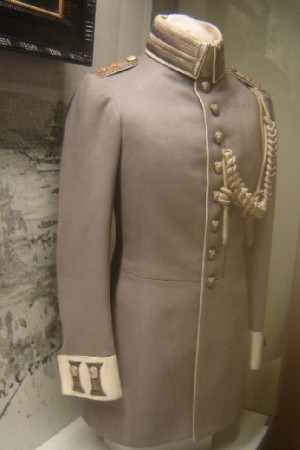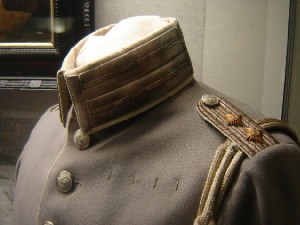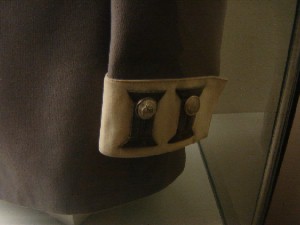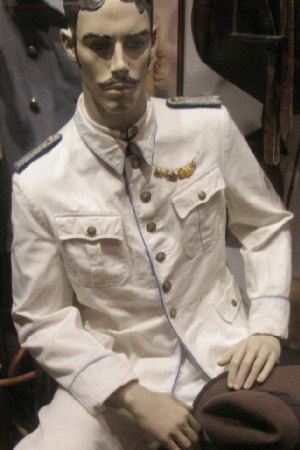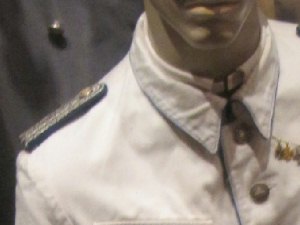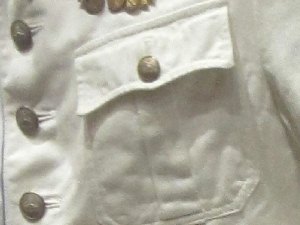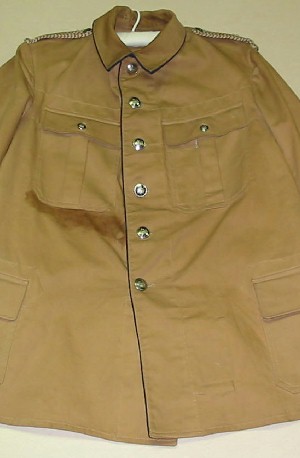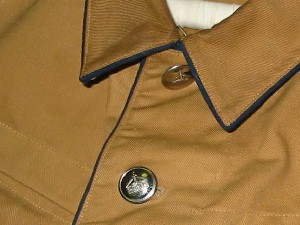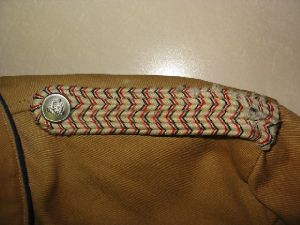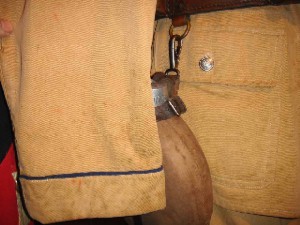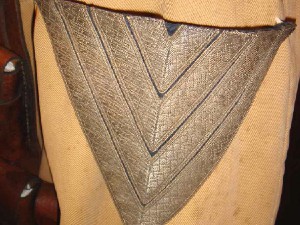|
German East African Schutztruppe
Officers
and NCOs 1896-1914 |
 |
 |
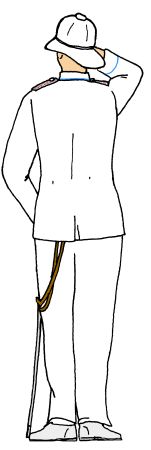 |
 |
 |
|
Figure 1
Schutztruppe Officer
Grey
Home Uniform |
Figure 2
Schutztruppe Officer
White Tropical Uniform |
Figure 3
Schutztruppe Officer
White Tropical Uniform |
Figure 4
Schutztruppe Officer
Khaki Tropical Uniform |
Figure 5
Schutztruppe NCO
Khaki Tropical Uniform |
| |
|
|
Uniforms of the German Officers and
NCOs of the Schutztruppe in East Africa 1896-1914
On 19th November 1896 new uniforms were authorised for German Schutztruppe Officers and NCOs.
Whereas pervious Schutztruppe uniforms were different for East
Africa and South West Africa
these new uniforms were worn by the Schutztruppe in all colonies with only minor variations. These
uniforms did not replace the old uniforms overnight, examples of the
Earlier Schutztruppe Uniforms are still seen in photographs up until the turn of the century. There were
three different types of the new uniform- a grey home uniform, white
tropical peacetime uniform and a khaki tropical field uniform. It was not unknown
to see officers and NCOs mixing items of white and khaki uniforms
together, while tailoring variations on privately purchased uniforms
were also not uncommon.
Grey Home Uniform
The grey uniform (known as the "Tuchuniform") was only worn by he East African Schutztruppe on
home duty back in Germany. Very occasional photographs show its use
by officers in East Africa. Unlike in South West Africa where the
grey uniform was on parade, the East African Schutztruppe wore their
white tropical uniform on parade in Africa.
The uniform was exactly as authorised
for the South West African
Schutztruppe (Grey cloth uniform with small white Litzen (large
white metallic Litzen for officers) on the stand and fall collar
and buttoned Swedish style cuffs, eight buttons down the front, no
pockets, scalloped rear skirts. All buttons were white metal and
bore the imperial crown.) except that the collar and cuffs were in
white for German East Africa as was the piping down the front,
around the rear skirts and down the trouser seems. White gloves were
authorised.
The grey uniform was authorised
on 11th March 1897, prior to then on 19th November 1896 a
Corduroy Uniform had
been authorised, similar to that worn in South West Africa but
with white collar, cuffs and piping. This uniform was discontinued
for East Africa after the regulations of 1897 and it is unknown if
it was ever actually worn. So far I have found no period photographs proving
its use.
| |
This
is a privately purchased officers uniform. The white
collar, cuffs and piping show that the original
owner served in the East African Schutztruppe. Note
the officers large Litzen on the collar (and smaller
on the cuffs). Also not the officers shoulder straps
with two pips showing the wearer to be a Hauptmann.
The tunic still has the aiguillette cords across the
left breast worn only on parade but does not have
the owner's medals, only stitch marks can be seen on
the left breast where they were once worn. |
|
|
White Tropical Uniform
The new white tropical uniform was authorised for the East African
Schutztruppe on 19th November 1896 and was worn for most peacetime,
garrison and parade
duties in East Africa.
The uniform was exactly as later
authorised for the
South West
African Schutztruppe (White tunic with blue piping on the stand and fall collar,
plain turn back cuffs and down the front. It had six white metal
buttons down the front, each bearing the Imperial crown and had four
buttoned pleated pockets. The hip pockets were sometimes unpleated
or omitted on privately purchased uniforms. The rear of the tunic
was plain).
The tunic was worn with matching
white trousers piped in blue (although the piping was sometimes
omitted on privately purchased trousers).
Khaki Tropical Uniform
The new khaki tropical uniform was authorised for the East African
Schutztruppe on 19th November 1896 and was worn for active duty in
the field in East Africa.
The uniform was exactly as
authorised for the South West
African Schutztruppe and of the same cut as the white uniform (Khaki
tunic with blue piping on the stand and fall collar, plain turn back
cuffs and down the front. It had six white metal buttons down the
front, each bearing the Imperial crown and had four buttoned pleated
pockets. The rear of the tunic was plain).
The tunic was worn with matching
khaki trousers piped in blue or riding breeches sometimes made of
corduroy.
| |
These are photographs of two different tunics, the
one on the left and the upper two photos being from
the Museum of the Boer Republics in Bloemfontein,
and the lower photos on the right being from a tunic
in the Doppler Collection. Both tunics were used in
South West Africa but identical tunics were worn in
East Africa. Note the blue piping worn by the
Schutztruppe for all colonies, the other ranks
shoulder straps in Imperial colours and the white
metallic lace rank chevron, in this case the four
chevrons of a Feldwebel. |
|
|
|
| |
|
|
|
Greatcoat
The greatcoat authorised on 19th November 1896 was exactly the same
as for the South West
African Schutztruppe (Grey cloth with a stand and fall collar
and plain turn back cuffs. It was double breasted for officers with
two rows of six white metal buttons and single breasted for other
ranks with one row of six white metal buttons. All buttons bore the
Imperial crown) except that officers of the East African
Schutztruppe had plain white collars and NCOs had grey collars with
white collar patches with Litzen and rank insignia. The greatcoat was not worn in East
Africa and was only needed on home duty in Germany.
Other Uniforms
Uniforms such as the Interimsrock, Litewka, Officer's cloak and mess
jacket were authorised for the East African Schutztruppe as for the
South West African Schutztruppe but with white rather than blue
distinctions. These uniforms were rarely worn in Africa and I have yet to see
their use in period photographs.
Shoulder Straps and Insignia
Other ranks shoulder straps for all uniforms were woven
from twisted cord in black/white/red. NCO rank insignia was shown in
the form of collar and cuff lace and buttons on the collar as was
worn by the regular imperial army (see
NCO Rank Insignia Page) on the
grey home uniform. NCOs rank insignia on the white and
khaki uniforms was worn in the form of white metallic lace chevrons
on the upper left arm.
Shoulder straps for junior officers were
woven from silver cord with black and red threads through it, on a
white backing. Senior
officers shoulder straps were woven from silver braid with black and
red threads. Officers wore sliver pips to display rank in the same
way as the imperial army (see Officers Rank
Insignia Page).
Specialist insignia as worn by the
Prussian army such as musicians swallow's nests, one year volunteer's shoulder board lace and marksmanship awards
were also worn on Schutztruppe uniforms but in Imperial colours rather
than Prussian where applicable (see
Specialist Insignia Page).
Aiguillette cords were worn across
the left breast on parade with all types of uniform. These were in
white metallic cord for officers or twisted cords in the imperial
colours for NCOs.
Headdress
Headdress for all ranks came in three types- a Südwester hat, a peaked field cap and a
tropical helmet.
Südwester
A grey felt Südwester slouch hat, similar to
that which had previously only been worn in South West Africa, was
introduced for the Schutztruppe of all colonies in 1896 (see
Südwester
Details Page). It was held up on the right
hand side with a large imperial cockade, although some photographs
show the hat was occasionally worn backwards with the cockade on the
left. The
hatband and edging were in colony colours (white for East Africa). Officers and senior NCOs
usually
wore privately purchased hats with slight variations in the size of
the brim, the quality of the hat and ribbon and with more elaborate
cockades (see
Cockades Details Page).The East African
Schutztruppe did not wear the Südwester hat in Africa very often,
although it was not unknown. Judging from period photographs, it was
usually reserved for use with the home uniform in Germany.
Tropical Helmet
On 19th November 1896
the new regulations kept the same basic form of the 1891 white helmet
(see
Tropical Helmets Details Page).
The eagle and spike were now dispensed with and the officers cord
was changed to a white metallic one. The small imperial cockade was
retained on the front. A khaki cover was worn on active service and
surviving examples and period photographs show that khaki helmets
were also frequently worn.
On 29th
December 1913 further regulations brought in a new helmet, lower in
height with a more rounded brim and only authorised in khaki (although a white cover could be
worn on parade). NCOs were now permitted to wear a black/white/red
twisted cord around the hatband.
Peaked Field Cap
A field cap, similar to that worn by officers and senior NCOs of the
Prussian army, was authorised for the Schutztruppe of all colonies in
1896 (see
Field Caps Details Page). It was grey
(to match the home uniform) with a black leather peak and hatband
and piping in colony colours (white for East Africa). On the front
of the hatband was a small imperial cockade. The cap was issued with
a wire retaining loop that held the shape of the top of the hat.
This loop was often removed to give a more comfortable appearance in
the field. Again officers and senior NCOs usually
wore privately purchased hats sometimes with slight variations in the colour
of the cloth (field grey cloth and brown corduroy were sometimes
used), height
of the peak, the quality of the hat and with more elaborate
cockades.
Footwear
The regulations of 1896 stated that officers could wear brown
leather riding boots (or often short ankle boots with leather
gaiters). Other ranks wore short brown leather ankle boots (with
dark blue/grey, later grey puttees in the tropics). Short white
leather ankle boots were worn with the white tropical uniform. The
regulations of 1897 for the home uniform stated that the boots
should be black leather though brown riding leather boots (or short
brown boots and gaiters) could be worn by mounted troops.
Equipment
NCOs wore brown leather equipment
with a the same Imperial crown belt buckle as worn by other ranks in
the navy. Officers wore the same belt of white
metallic lace with red and black horizontal stripes with an imperial belt
buckle as worn by officers of the Imperial navy, though many
officers are seen in period photographs wearing other ranks or
privately purchased brown leather belts either with the other ranks
buckle or an open buckle.
Minimal equipment was carried in the field. Porters carried most
heavy items, so period photographs usually show German officers and
NCOs carrying only a pistol, binoculars and a water bottle.
Weapons
Officers and senior NCOs were
entitled to carry an 1889 Prussian infantry officers sword with an
Imperial eagle on the hilt. Swords were not usually carried in
action. Officers and senior NCOs were usually
armed only with a pistol in the field. The Reichsrevolver 79/83 as
well as the Luger 08 would probably have been the most common in
use.
The Jägerbüchse 71 rifle was original
carried by junior NCOs, but these had all been replaced with the Kar98AZ
carbine before the First World War for German personnel. The S71/84
bayonet was issued with the Jägerbüchse 71. The kS98 bayonet was
issued with the Kar98AZ carbine.
|
|
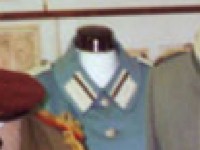
East African NCOs Greatcoat
(See Siebentritt Collection Page)
Photo © Traditionsverband
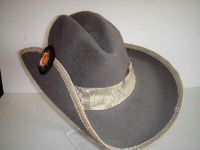
East African Schutztruppe Südwester
(See
Südwester
Details Page)
Photo
© Doppler
Collection
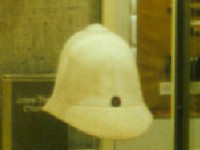
Schutztruppe Tropical Helmet
(See Siebentritt Collection Page)
Photo © Traditionsverband

Binoculars used in East Africa
(See
East African Binoculars)
Photo © Gilles Sigro
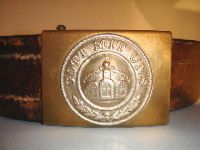
Schutztruppe NCOs Belt Buckle
(See
Belt Buckle Details Page)
Photo ©
Doppler Collection
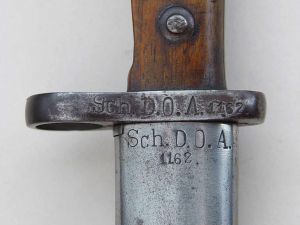
East African S71/84 Bayonet
(See
East African Bayonets Page)
Photo ©
Roy Williams

Schutztruppe Officers Sword
(See
Swords Page)
Photo © Leonid Lantsman
|
| |
The Illustrations |
|
| |
Figure 1 is based on a
photograph of an Oberleutnant Paul Graetz of the East African Schutztruppe in
the Grey Home
Uniform with the Südwester hat. Note the white collar, cuffs and piping
for East Africa. His shoulder straps for
officers have one rank pip showing him to be an Oberleutnant
(see
Officers Rank
Insignia Page). This
officer has been awarded the Colonial Campaign Medal (instituted
in 1912) which he
wears on his left breast and below that the white metallic
aiguillette cords worn by Schutztruppe
officers on parade. The matching grey riding breeches are also
piped in white. He wears privately purchased brown leather
riding boots and carries a pair of authorised white gloves. His
sword is the 1889 Prussian Infantry officers sword for Schutztruppe officers sword with an imperial eagle
on the hilt and a sword knot in white metallic lace.
| |
Oberleutnant Paul Graetz (1875-
1968) originally served in the 106th Saxon Infantry Regiment "Prince
George", before being transferred to the East African Schutztruppe and
given the task of road building in the colony. Between 1907 and 1909 he
made an historic epic journey by car with Theodore von Roeder from Dar es
Salaam in German East Africa to Swakopmund in German South West Africa. This was
the first crossing of Southern Africa in a motorised vehicle and is
described in Graetz's book, "Im Auto quer durch Afrika". When the First
World War broke out he was back in Germany planning an airship expedition
to New Guinea but was soon instead put in charge of the Flying school and
Fokker factory at Schwerin. While living in Dresden after the First World
War, he was involved in setting up the fore-runner of the German airline
company, Lufthansa. In 1949 he escaped from Soviet East Germany and died
in Travemünde in West Germany in 1968. |
Figure 2 is based on a photograph of an Officer of the East
African Schutztruppe, Hauptmann Robert von Beringe in white tropical uniform
with peaked field cap. Note the blue piping on the uniform and
officers shoulder straps with two pips showing him to be a
Hauptmann (see
Officers Rank
Insignia Page). His field cap is grey to match the home uniform with
white hatband and piping for East Africa. He wears white ankle
boots to match the white uniform. He wears an NCOs belt and
buckle, which seems to have been common practice amongst
officers in Africa, presumably as it was more practical.
| |
Friedrich
Robert von Beringe (1865-1940)
followed his father as a cavalry officer by joining the 1st
Prussian Hussars (Leib-Husaren
Regt. Nr.1) in
1894 where he became a close friend of August von Mackensen.
He later transferred to the German East African
Schutztruppe and saw action against several rebellious
tribes while commanding the 9th Field Company based at
Usumbura (now known as Bujumbura, the capital of Burundi).
In 1902 while on an expedition to Mount Sabinyo he shot and killed
two gorillas that were later identified as a separate
sub-species now commonly known as the Mountain Gorilla but
officially classified as Gorilla Gorilla Beringei in his
honour. The gorillas found fame in the film "Gorillas in the
Mist" while a plaque commemorates von Beringe at the Virunga
Conservation Area, where the Democratic Republic of the
Congo, Rwanda and Uganda meet. In 1906 he returned to
Germany, was promoted to major in 1908 and retired from
military service in 1913.
Recommended External
Link-
The Man who Discovered the Mountain Gorilla at Berggorilla
Website |
Figure 3 is based on a
photograph
of an Officer of the East African Schutztruppe in white tropical uniform. This view shows the plain rear of the tunic with neither
buttons nor piping on the skirts. Again note the officers shoulder
straps. He wears the tall 1896 white tropical helmet with a
white metallic cord around the hatband. Again he wears short
white boots and carries a Schutztruppe officers sword.
Figure 4 is based on a photograph
of a German Schutztruppe Officer wearing the khaki tropical uniform
piped in blue. As mentioned above it was of identical cut to the
white uniform. His trousers are matching khaki piped in blue.
His cap is the grey field cap with hatband and piping in white
for East Africa. Note that like many officers and NCOs in Africa
he has removed the wire retaining loop from the cap giving it a
less stiff appearance around the upper edge. Again he wears the
more practical NCOs belt and buckle. He wears brown leather
ankle boots and gaiters and like many officers in the field,
carries a pair of binoculars.
Figure
5 is based on a
photograph
of a German East African Schutztruppe NCO wearing the khaki tropical
uniform piped in blue. His NCOs shoulder straps are from twisted cords
in the imperial colours. His rank is shown by the chevrons on his upper
left arm. He wears the khaki tropical helmet authorised from 1912. It
was lower and more rounded in shape than the earlier white helmets and
had twisted cords in imperial colours around the hatband for NCOs. Again
he carries a useful pair of binoculars. He wears brown leather ankle
boots with grey puttees.
|
|
| |
|
|
| |
|
|
| |
Period Photographs |
|
|
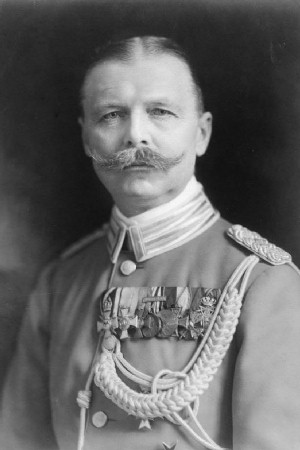
Photo from
Bundesarchiv /
WikiCommons |
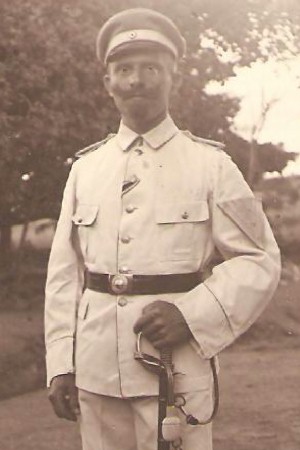
Photo
© Peter Klein |

Photo
© JW Collection |
The photograph above left shows
Oberstleutnant von Schleinitz, Commander of the East African
Schutztruppe in 1912 wearing the 1897 grey home uniform. Note the white
piping and collar for East Africa, the large officers white metallic
Litzen, the parade aiguillette cords and the thick braided shoulder
boards of a senior officer. His impressive medal bar incldes the
Prussian Order of the Red Eagle with crown and swords, Prussian Crown
Order, Prussian Officwrs Long Service Cross, Colonial Service Medal with
a clasp (probably for Deutsch Ost-Afrika 1905/07), Prussian Wilhelm I
Centenary Medal, possibly a Mecklenburg-Schwerin Military Merit Cross,
Baden Order of the Zähringer Lion with swords and another states' medal
with crown and swords.
| |
Kurt Hans Julius Freiherr
von Schleinitz (1859-1928) was
a Prussian officer from a military family who transferred as
Hauptmann to the East African Schutztruppe in 1900. In 1907
following the Maji-Maji Rebellion he was given command of the
Schutztruppe of East Africa. He retired back to Germany in April
1914, being replaced by Oberstleutnant von Lettow-Vorbeck. |
The photograph above centre shows
a Feldwebel of the East African Schutztruppe
wearing the 1896 white tropical uniform of the Schutztruppe piped in
blue. The shoulder straps for non-commissioned officers were made of
cords in the imperial colours. A group of four chevrons (in white
metallic lace edged in blue- see
NCO Rank Insignia Page) denoting him as a Sergeant Major ("Feldwebel")
can been seen on his left arm. In his second buttonhole is
the ribbon of a medal. It appears to be black and white, so would
presumably be for a Prussian decoration such as the Military Honour
Award or the Warriors Merit Medal. It seems unlikely to have been an
Iron Cross, as very few were ever distributed in East Africa and even
then only after a delivery in 1916 by the blockade running ship, Marie.
The white uniform and sword were not commonly worn after the outbreak of
the First World War.
He wears a grey peaked field
cap with hatband and piping in white (for East Africa) and a small
imperial cockade on the front. Trousers and shoes are matching white.
He wears an NCOs brown
leather belt and buckle. As a senior NCO he is entitled to carry a
sword, probably the 1889 Prussian Officers sword with an officers sword
knot ("Portepee") in white metallic lace with black and red
threads.
The photograph above right shows an East African Schutztruppe Unteroffizier
wearing the 1896 Khaki Uniform. It is piped in blue and has a single
white metallic lace chevron on the upper left arm denoting his rank. The
buttons are in white metal with an imperial crown on each and the
shoulder straps are twisted wool in the imperial colours. He wears the
grey peaked cap matching his home uniform with black leather peak,
single imperial cockade and a white hatband and piping for East Africa.
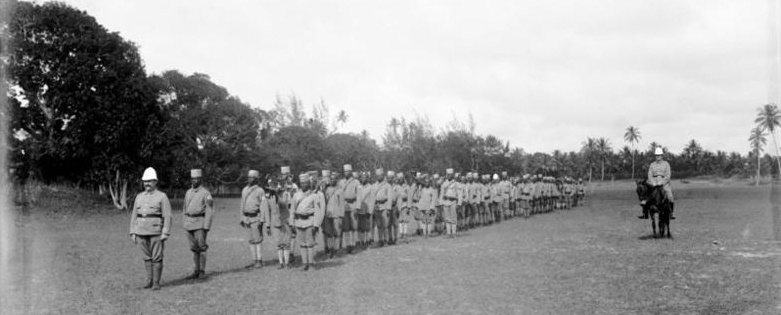
Photo by Walther Dobbertin from
WikiCommons/Bundesarchiv
This photograph shows a
Schutztruppe Feldkompagnie in marching order as they would have appeared
on campaign c1896-1914. The mounted officer to the right and the NCO at
the head of the column both wear the 1896 khaki uniform with the 1891/96
tall white tropical helmet. The NCO wears puttees with short ankle
boots. The Askaris wear khaki
uniforms with khaki tarbushes.
Main Sources
"Bekleidungs-Vorschrift für die
Kaiserlichen Schutztruppen in Afrika" (Uniform
regulations for the Imperial Schutztruppe
in Africa), 19/11/1896, 11/3/1897, 1898 and 29/12/1913. I got my printed copy from Deutsche Kolonien und Militaria on Ebay. Much of it can be
found on the
Traditionsverband Forum.
"Lettow-Vorbeck's Soldiers" by Walther Dobbertin
(Battery Press)
"The
German Colonial
Troops 1889-1918" by
Jürgen
Kraus and Thomas Müller (Verlag Books)
"Die Deutsche Schutztruppe
1889/1918" by Werner Haupt (Dörfler Publishing)
Photographs from the
Frankfurt University
Colonial Archives and the
Axis History Forum
See Book Reviews Page
for more on these books and links to order them.
|





